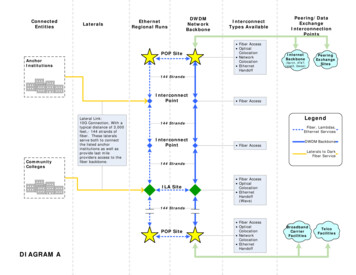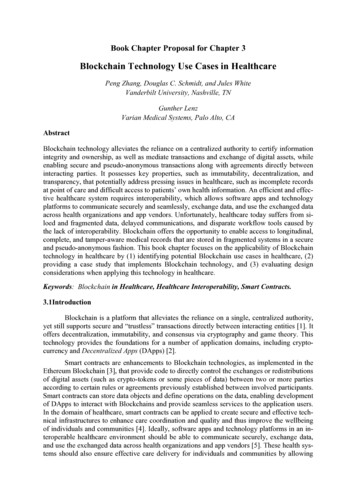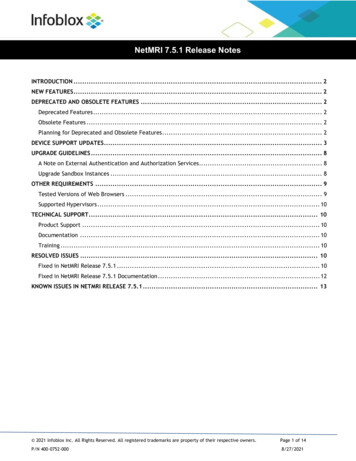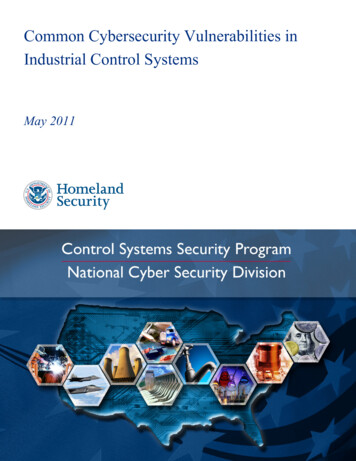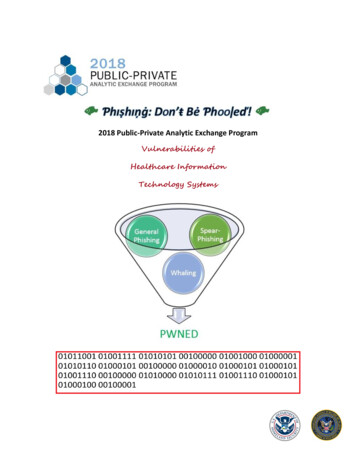
Transcription
2018 Public-Private Analytic Exchange ProgramVulnerabilities ofHealthcare InformationTechnology Systems
Table of ContentsAcknowledgement . iiExecutive Summary. 1Level Setting and Cyber Threat Landscape . 2An Introduction to Phishing . 2Psychology of Phishing . 5Anatomy of a Phishing Attack . 7New Phishing Techniques . 8Mitigating Phishing Attempts . 9Conclusion and Recommendations . 12Appendix A: Sample Phishing Emails Received by Healthcare Organizations . 13Appendix B: Where to Report Phishing . 25i
AcknowledgementWe acknowledge and thank the federal government agencies and companies that supported thedevelopment of this paper. We also thank the Office of the Director of National Intelligence (ODNI) andthe U.S. Department of Homeland Security (DHS) for the opportunity to have participated in the 2018Public-Private Analytic Exchange Program (AEP).People and Organizations ConsultedWe are grateful to the individuals and companies that provided their time to advise, answer questions,and assist in developing the information in this report: Axel Wirth, Distinguished Technical Architect, Healthcare Practice, Symantec Corporation Dermot Harnett, Director of Development, Security Technology and Response (STAR), SymantecCorporation Vikram Thakur, Technical Director, Security Technology and Response (STAR), Symantec Corporation Jason Hawley, Director of Information Services and Security Kevin Johnson, Secure Ideas Bayardo Alvarez Paul Scheib, Senior IT Director, Boston Children’s Hospital Jigar Kadakia, Chief Information Security and Privacy Officer, Partners HealthCare Debbie Mikels, OTR/L, FHIMSS, Information Security Program Manager, Partners HealthCare Martin McKeay, Akamai Technologies Josh Corman, I am the Cavalry Julian M. Goldman, MD, Director, Medical Device Interoperability & Cybersecurity Program,Massachusetts General Hospital; Medical Director, Partners HealthCare Biomedical Engineering;Anesthesiologist, Massachusetts General Hospital Al Roeder, HCCIC, OCIO, U.S. Department of Health and Human Services Kevin Allen Dorsey, Deputy CISO, Centers for Medicare & Medicaid Services, U.S. Department ofHealth and Human Services Stephen Curren, Director, Division of Resilience, Office of Emergency Management, AssistantSecretary for Preparedness and Response, U.S. Department of Health and Human Services Nick Heesters, Office for Civil Rights, U.S. Department of Health and Human ServicesPublic/Private Team Members Hany Wassef, Meritor Bruce de’Medici, Grey Oar Lee Kim, JD, CISSP, CIPP/US, Healthcare Information and Management Systems Society Sandra Hemmes, Humana Chris Letterman, Wostmann & Associates Kevin Littlefield, MITRE Corporation G. Squire, National Security Agency C. Myers, National Security Agency S. Dixon, Central Intelligence Agency Torrey Kingcade, U.S. Department of Justice Benjamin Amsterdam, U.S. Department of Defense William Pachucki, CISSP, U.S. Department of Health and Human Servicesii
Executive SummaryPhishing is a significant threat to everyone, including healthcare organizations. Many significant securityincidents originate with a successful phishing attempt. Inboxes are no longer clogged with “junk mail”,but rather with phishing emails designed to elicit sensitive information, deploy malware, or achieveanother end.Malicious actors know that phishing is a highly effective means to penetrate an organization and itspeople. The phishing threat is constantly evolving. Thus, the asymmetric threat is real. Defensecapabilities often pale in comparison to offensive capabilities in the healthcare and public health(“HPH”) sector. Human and technical controls either do not evolve or tend to evolve slowly in manyhealthcare organizations.But, there are some small, medium, and large healthcare organizations that have sophisticatedcybersecurity programs in place. These organizations practice defense in depth and have successfullyintegrated their people, processes, and technology to work as one unified whole. While achieving onehundred percent security is generally not possible, the advantage of having a robust cybersecurityprogram is that the blocking and tackling occur much more quickly and efficiently.Through a series of virtual and in person interviews, literature reviews, and other engagement, thiseducational paper provides a holistic perspective on phishing: what it is, how effective it is, the impact,how phishing occurs, what some new phishing techniques are, and how to mitigate the phishing threat.1
Level Setting and Cyber Threat LandscapeTraditionally, many healthcare organizations approached healthcare cybersecurity from a compliancebased perspective. The top concern was having a data breach. But, a significant turning point was inAugust 2014 when a major hospital system made a public announcement to the media that it had beenthe victim of a significant cyber-attack and 4.5 million patient records had been breached.1 Since then,cyber-attacks and other compromises have grown in sophistication, volume, and frequency. Further,while data breaches continue to occur, healthcare organizations must now worry about compromisesinvolving the integrity and availability of data (e.g., ransomware, denial of service, insider threat, etc.).While many healthcare organizations are improving the state of their cybersecurity programs, suchimprovements may not be enough to sufficiently stay ahead of the threats. The threats are numerousand complex. Attackers look for open doors or windows into organizations. An efficient and effectiveway into healthcare organizations is through social engineering (i.e., exploiting the human factor).2Phishing is a pervasive threat for all organizations. Healthcare organizations, too, are vulnerable.3An Introduction to PhishingPhishing is a social engineering tactic that is used to persuade individuals to provide sensitiveinformation and/or take action through seemingly trustworthy communications. 4 The three majorcategories of phishing are as follows: (1) general phishing, (2) spear-phishing, and (3) whaling. Maliciousactors employ phishing techniques for a variety of reasons, including identity theft, access to proprietaryinformation, transmission of malicious software to include ransomware, unauthorized remote access,and initiation of unauthorized financial transactions.The most common form of phishing is the phishing email. Phishing emails may attempt to appeal to arecipient’s fear, duty, obligation, curiosity, or greed.5 Early forms of phishing emails (i.e., generalphishing) did not target specific individuals. Such phishing emails are still prevalent today and contain1See Jim Finkle and Caroline Humer, Community Health Says Data Stolen in Cyber Attack from China, available 2See Ina Wanca and Ashley Cannon, How Human Behavior and Decision Making Expose Users to Phishing Attacks,available at hing-Attacks.pdf.3See Wombat Security Technologies, 2018 Beyond the Phish: Protect Your Organization from Threats Including andBeyond Phishing, available at 18 (healthcare ranks nearthe bottom in terms of cybersecurity knowledge, but virtually all industries share a common weakness: identifyingphishing threats).4See Mark Smith, Social Engineers Reveal Why the Biggest Threat to Your Business Could Be You, available eatbusiness.5See, e.g., NCCIC, Assessment Summary Phishing Campaign Assessment Summary Office of Example ment-ReportFY2018.pdf and Paul Chauvet, Let’s Go Phishing a Technical and Psychological Talk on Social Engineering, availableat ts Go on 1.0.2
hallmarks such as poor grammar, spelling, and, often, “too good to be true” claims.6,7 A phishing emailmay appear to originate from a well-known company, agency, university, or individual.8,9 Examples ofgeneral phishing, spear-phishing, and whaling emails may be found in Appendix A.A general phishing email may elicit sensitive information or money from the recipient and/or containmalicious hyperlinks, attachments, and code.10,11 Thus, opening an email message (which may have amalicious script, image, and/or video) or, an attachment, and/or clicking on a malicious link may lead tocompromise. Because general phishing is an untargeted form of attack, malicious actors typically cast awide net with the hope that some recipients take the bait.In contrast, spear-phishing is a targeted phishing attack.12,13 Spear-phishing is a popular infection vectorfor malicious actors.14 Spear-phishing messages are tailored to the target recipient (e.g., individual orgroups within an organization).15 There is a plethora of information available online about companies,their employees and contractors, current and past projects, policies and procedures, and their vendorsand business associates. Spear-phishing messages may be particularly convincing when they contain“insider information” relevant to the targeted organization or individual. In addition, spear-phishing has6See HIMSS, Don’t Catch that Phish – How to Not Become a Victim, available at me-victim.7See Jason Milletary, Technical Trends in Phishing Attacks, available at tions/phishing trends0511.pdf.8See, e.g., Jindrich Karasek, New Phishing Scam Uses AES Encryption and Goes After Apple IDs, available and-goesafter-apple-ids/.9See EDTS, 15 Examples of Phishing Emails from 2016-2017, available at ing-emails-from-2016-2017.10See Sophos, Office DDE Attack Works in Outlook Too – Here’s What to Do, available o/. Seealso Mimecast, ROPEMAKER Email Security Weakness - Vulnerability or Application Misuse?, available g-the-ropemaker-email-exploit/ and Doug Olenick, 2018Winter Olympics Being Used As Phishing Attack Bait, available at See Jonathan Crowe, Must-Know Phishing Statistics 2017, available at See NIST Computer Security Resource Center, Glossary, available at https://csrc.nist.gov/Glossary/?term 1896(defining spear-phishing) and EDTS, 15 Examples of Phishing Emails from 2016-2017, available ishing-emails-from-2016-2017.13See MITRE Partnership Network, Spearphishing Link, available See Symantec Corporation, Internet Security Threat Report Volume 23, available cs/reports/istr-23-2018-en.pdf (“Spear-phishing emailsemerged as by far the most widely used infection vector, employed by 71 percent of groups.”).15See Trend Micro, Spear Phishing, available at ition/spearphishing.3
been made more effective through the use of stolen vendor credentials.16 Thus, spear-phishing hasbeen used to target healthcare organizations, either directly or indirectly (such as through vendors).17Similarly, whaling is defined as a targeted phishing attack that is aimed at wealthy, powerful, orprominent individuals (e.g., C-suite executives such as chief financial officers and chief executiveofficers, politicians, and celebrities).18,19,20 But, others use the term “whaling” to mean an attack thatinvolves malicious actors masquerading as such individuals.21 As an example, a malicious actor maymasquerade as a hospital’s chief financial officer (“CFO”) and trick the recipient into divulging bankaccount information, employee information, corporate financial information, and/or transferring fundsto an account that is controlled by the actor.22According to recent studies, the initial point of compromise for significant security incidents is generallyby way of phishing.23,24 These security incidents may adversely affect the confidentiality, integrity,and/or availability of information (e.g., protected health information, personally identifiableinformation, employee information, intellectual property, and other sensitive information). But, thegreatest risk to healthcare organizations is patient safety. Threats to patient safety may exist as a resultof any compromise to the confidentiality, integrity, and/or availability of information.25 Thus, somethingseemingly as simple as phishing needs to be addressed, as a successful attack may open the door topatient safety issues.16This type of attack has been prevalent since at least 2014. A major cyber-attack affected a well-known retailer inDecember 2013.17See Trend Micro and HITRUST, Securing Connected Hospitals: A Research on Exposed Medical Systems andSupply Chain Risks, available at ring-Connected-Hospitals.pdf(“Spear phishing from trusted email account”).18See Trend Micro, Whale Phishing, available at ition/whalephishing.19See TechTarget, Whaling, available at haling.20See EDTS, 15 Examples of Phishing Emails from 2016-2017, available at ing-emails-from-2016-2017.21See Vincent Voci, CEO Email Fraud: How to Combat a Whale of a Problem, available ceo-email-fraud-how-combat-whale-problem.22See Mimecast, Whaling Attack, available at https://www.mimecast.com/content/whaling-attack/. See also FBI,Business E-Mail Compromise: Cyber-Enabled Financial Fraud on the Rise Globally, available -compromise-on-the-rise and FedScoop, How One CompanyLost 40M from an Increasing [sic] Popular Email Scam, available at lion-ceo-hack-september-2016/.23See HIMSS, 2018 HIMSS Cybersecurity Survey, available at y.24But, the initial attack vector may also be a means other than phishing. See, e.g., Department of Health & SocialCare, NHS Improvement, and NHS England, Lessons Learned Review of the WannaCry Ransomware Cyber Attack,available at r-attack-cio-review.pdf.25See Independent Security Evaluators, Hacking Hospitals, available .4
Anyone can be a victim of a phishing attack, including end users and information technologyprofessionals.26 People who do not consider themselves to be trusting by nature may be vulnerablewhen presented with a convincing story.27Factors which may make people more susceptible include using a mobile device (as it may be moredifficult to scrutinize links and content of messages),28 accessing email outside of regular business hours,and being mentally fatigued (e.g., early morning, late in the day, etc.).29 But, malicious links may beobfuscated as well. Malicious actors use shortened uniform resource locator (“URL”) services to masktheir (malicious) links in emails, text messages,30 and social media messages.31,32Psychology of PhishingPhishing attacks may be used by malicious actors to defeat security controls by exploiting weaknesses indecision making and human behavior. Such attacks often rely on a combination of tactics to influencedecision making such as authority, time pressure, and tone, as people tend to comply with requestsfrom authority figures. This is why phishing emails that claim to be from a trusted source with acorporate logo or name appear to have legitimacy and credibility. Further, clues to the fraudulentnature of phishing scams often fall below the threshold of the average recipient.33Phishing messages often contain an element of urgency and, thus, time pressure. The tone of thesemessages frequently involves a combination of persuasive and polite statements to also influencedecision making. Such messages may also prey on a user’s fear of something, such as an accountrestriction or leverage current events, or these messages may seek to psychologically manipulate orexploit the emotions of the victim.3426See Alison DeNisco Rayome, Report: Phishing Attacks on the Rise, Executives and IT Workers Most Likely to FallVictim, available at st-likely-to-fall-victim/. “Entry-level employees—commonly blamed for cyber breaches—are not theonly ones at fault, the report found: 34% of executives/owners and 25% of IT workers themselves report beingvictims of a phishing email, more often than any group of office workers.” Id.27See Vicky Sidler, Why Phishing Attacks are So Effective, available at 8/why-phishing-attacks-are-so-effective/.28See Belal Amro, Phishing Techniques in Mobile Devices, 6 JOURNAL OF COMPUTER AND COMMUNICATIONS 33, 27-35(2018) available at .pdf.29See Stilgherrian, Resilience to Phishing Attacks is Failing to Improve, available hing-attacks-is-failing-to-improve/.30This is called SMiShing or smishing. See, e.g., Marc Saltzman, 'Smishing' Scams Target Your Text Messages.Here's How to Avoid Them, available onyour-smartphone/439647001/.31See, e.g., Jérôme Segura, Compromised LinkedIn Accounts Used to Send Phishing Links via Private Message andInMail, available at hing-links-via-private-message-and-inmail/.32Cf., Shady URL, available at http://www.shadyurl.com/. In contrast, this service makes URLs seem shady.33See Don Mosley, Some Psychological Factors of Successful Phishing, available athttp://www.infosecwriters.com/text resources/pdf/Phishing DMosley.pdf.34See Robin Gonzalez and Michael E. Locasto, An Interdiscplinary [sic] Study of Phishing and Spear-PhishingAttacks, available at les.pdf.5
In the case of spear-phishing, such messages may appear quite convincing by leveraging insiderknowledge about job functions, work relationships, current projects, etc.35There are some users, however, that tend to have certain personality traits and characteristics thatmake them more susceptible to phishing. 36 For example, users who have a strong commitment to theirorganization and exhibit agreeableness may have a greater degree of susceptibility. But, well-designedsecurity awareness training and education can benefit all groups and demographics of people to reducethe number of victims falling prey to phishing attacks.37Most Clicked General Email Subject Lines Globally for Q1 2018.1.2.3.4.5.6.7.8.9.10.A Delivery Attempt Was Made - 21%Change of Password Required Immediately - 20%W-2 - 13%Company Policy Update for Fraternization - 10%UPS Label Delivery 1ZBE3112TNY00015011 - 10%Revised Vacation and Time Policy - 8%Staff Review 2017 - 7%Urgent Press Release to All Staff - 5%Deactivation of (email) in Process - 4%Please Read: Important from HR - 2%However, even the most sophisticated users have been fooled by some visual deception tricks used inphishing. In one study, good phishing websites fooled ninety percent of the participants. For example,users may be fooled by “typejacking” attacks which substitute letters (e.g., www.paypa1.com) or otherlookalike characters (such as homographs, also referred to as homoglyphs). In another example, animage of a legitimate hyperlink leading to a rogue link may fool users. Yet another example of atechnique is to place an illegitimate browser window on top of, or next to, a legitimate window, therebytricking users into mistakenly believing that both windows are from the same source. 3835See Ina Wanca and Ashley Cannon, How Human Behavior and Decision Making Expose Users to Phishing Attacks,available at hing-Attacks.pdf.36See James L. Parrish, Jr., Janet L. Bailey, James F. Courtney, A Personality Based Model for DeterminingSusceptibility to Phishing Attacks, available at ee Steve Sheng et al., Who Falls for Phish? A Demographic Analysis of PhishingSusceptibility and Effectiveness of Interventions, available at http://lorrie.cranor.org/pubs/pap1162-sheng.pdf. Seealso Health Care Industry Cybersecurity Task Force, Report on Improving Cybersecurity in the Health Care Industry,available at Documents/report2017.pdf (Imperative 4.Increase health care industry readiness through improved cybersecurity awareness and education).38See Rachna Dhamija, J.D. Tygar, and Marti Hearst, Why Phishing Works, available athttp://people.ischool.berkeley.edu/ tygar/papers/Phishing/why phishing works.pdf.6
Anatomy of a Phishing AttackThere are generally six steps involved in a phishing attack:391. Identify the target. The malicious actor determines who or what to target and how to obtainthe email addresses. The malicious actor may decide to do a mass email to a large number ofemail addresses (i.e., general phishing), or the target may be specific (i.e., spear-phishing orwhaling). But, before the malicious actor needs to collect the email addresses of his or herintended victims. Email addresses may be harvested from the Internet.40 Email address listsmay also be purchased from third parties. Email addresses may also be generated via adictionary attack.412. Craft the message. The malicious actor crafts the message with content that is designed tomake the recipient take some action, such as open a message, open an attachment, click onmalicious link(s), and/or respond to a message. If the malicious actor wants to conduct ageneral phishing attack, then the message crafted by the actor is one size fits all. However, inthe case of a spear-phishing or whaling attack, the message is customized for the target.42 Themalicious actor may also generate the malicious payload to accompany the crafted message.43Further, the malicious actor may clone a legitimate website to make a phishing website that heor she controls.443. Deliver the message. The malicious actor sends the message to the target(s), typically with aspoofed email address for the sender of the message.454. Deception. If the phishing attack is successful, the recipient of the message is deceived intotaking the intended action or providing the desired information.5. Action by recipient. The recipient performs the intended action.6. Disclosure. The recipient discloses the requested information (to the extent that the phishingmessage requests certain information).7. Action by malicious actor. The malicious actor uses the collected information for his or her end.The information may benefit the malicious actor financially or in other ways.39See Dan Maier, 10 Steps You Can Take to Protect Your Business From Phishing Attacks, available cks.40See, e.g., Kali Tools, theHarvester, available at rvester,Rapid7, Vulnerability & Exploit Database, available er/search email collector (Metasploit auxiliary module), andPaterva, available at https://www.paterva.com (Maltego).41A dictionary attack with a list of usernames may be used to guess the email addresses for a domain. See alsoFTC, Candid Answers to CAN-SPAM Questions, available at /2015/08/candid-answers-can-spam-questions. The FTC notes that email lists (for purchase) may have beenput together using illegal means like email address harvesting or dictionary attacks.42See Asaf Cidon, Multi-Stage Spear Phishing – Bait, Hook and Catch, available hook-andcatch.html.43The malicious payload may be generated using the Social-Engineer Toolkit (“SET”), Metasploit, MSFvenom, andother tools.44Tools for cloning websites include Grab-a-Site, HTTrack and SET.45The message(s) may be sent using tools such as SET.7
New Phishing TechniquesHijacking of email threads with a malicious actor masquerading as a trusted colleague, friend, or familymember is a new technique used for phishing attacks. This can happen, for example, to two chiefinformation security officers (“CISOs”) at different healthcare organizations who are having aconversation via email. The malicious actor may pose as one of these CISOs, tricking the other CISO intoopening a malicious attachment.Typejacking and/or homograph attacks may also be used to fool the recipient of a phishing message.Specifically, the sender’s domain name may look like a well-known or trusted domain name, but itactually is a “lookalike” domain name. (An example of a “typejacking” domain name is “examp1e.com”instead of “example.com.” An example of a homograph domain name is “dıṣh.com” instead of“dish.com.”) Specifically, a malicious actor may leverage the similarities of character scripts to createand register phony domain names that look like a trusted domain name. Thus, a phishing website couldbe created using the phony domain name to fool users and lure them into visiting.46 Yet anotherphishing technique involves dynamic data exchange (“DDE”) attacks using emails and calendar invitesthat have been formatted in rich text format (“RTF”).47Artificial intelligence may also be used to conduct (or simulate) spear-phishing attacks. For example,researchers have devised a fully automated spear-phishing system that creates tailored tweets based ona user’s interests, achieving a high click rate for links that could be malicious.48 Yet other researchershave devised an artificial intelligence system for automated spear-phishing which includes automaticconstruction and communication of a spear-phishing message that is tailored to the victim usinginformation that is unique to that individual.49Situational awareness, security awareness training, and defense in depth are key strategies to thwartphishing attempts. The phishing threat is always evolving and so should human and technical controls.It is predicted that spear-phishing attacks will increase with the malicious use of artificial intelligence.46See Jovi Umawing, Out of Character: Homograph Attacks Explained, available -character-homograph-attacks-explained/ and Crypto-IT,Homograph Attack, available at ack.html. See also RachnaDhamija, J.D. Tygar, and Marti Hearst, Why Phishing Works, available athttp://people.ischool.berkeley.edu/ tygar/papers/Phishing/why phishing works.pdf.47See Sophos, Office DDE Attack Works in Outlook Too – Here’s What to Do, available o/ andJoshua Shilko, Office DDE Feature Exploited to Deliver DNSMessenger Payload in New Targeted Phishing Campaign,available at -new-targeted-phishing-campaign/.48See Future of Humanity Institute, University of Oxford, and the Centre for the Study of Existential Risk, TheMalicious Use of Artificial Intelligence: Forecasting, Prevention, and Mitigation, available 28.pdf (citing John Seymour and Philip Tully,Weaponizing Data Science for Social Engineering: Automated E2E Spear Phishing on Twitter, available -16-Seymour-Tully-Weaponizing-Data-Sci
3 hallmarks such as poor grammar, spelling, and, often, "too good to be true" claims.6,7 A phishing email may appear to originate from a well-known company, agency, university, or individual.8,9 Examples of general phishing, spear-phishing, and whaling emails may be found in Appendix A. A general phishing email may elicit sensitive information or money from the recipient and/or contain




